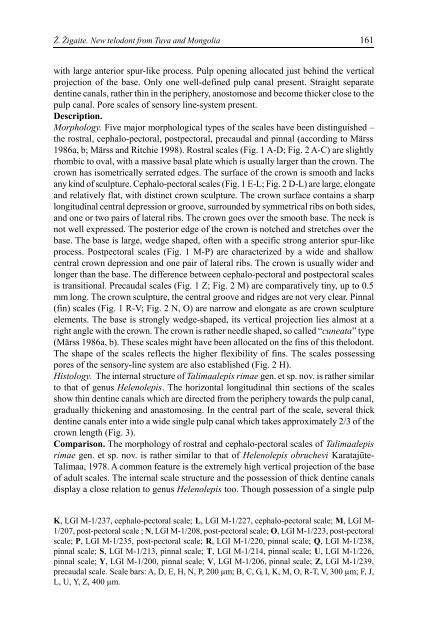Zemes un vides zinātnes Earth and Environment Sciences - Latvijas ...
Zemes un vides zinātnes Earth and Environment Sciences - Latvijas ...
Zemes un vides zinātnes Earth and Environment Sciences - Latvijas ...
Create successful ePaper yourself
Turn your PDF publications into a flip-book with our unique Google optimized e-Paper software.
Ž. Žigaite. New telodont from Tuva <strong>and</strong> Mongolia 161<br />
with large anterior spur-like process. Pulp opening allocated just behind the vertical<br />
projection of the base. Only one well-defined pulp canal present. Straight separate<br />
dentine canals, rather thin in the periphery, anostomose <strong>and</strong> become thicker close to the<br />
pulp canal. Pore scales of sensory line-system present.<br />
Description.<br />
Morphology. Five major morphological types of the scales have been distinguished –<br />
the rostral, cephalo-pectoral, postpectoral, precaudal <strong>and</strong> pinnal (according to Märss<br />
1986a, b; Märss <strong>and</strong> Ritchie 1998). Rostral scales (Fig. 1 A-D; Fig. 2 A-C) are slightly<br />
rhombic to oval, with a massive basal plate which is usually larger than the crown. The<br />
crown has isometrically serrated edges. The surface of the crown is smooth <strong>and</strong> lacks<br />
any kind of sculpture. Cephalo-pectoral scales (Fig. 1 E-L; Fig. 2 D-L) are large, elongate<br />
<strong>and</strong> relatively flat, with distinct crown sculpture. The crown surface contains a sharp<br />
longitudinal central depression or groove, surro<strong>un</strong>ded by symmetrical ribs on both sides,<br />
<strong>and</strong> one or two pairs of lateral ribs. The crown goes over the smooth base. The neck is<br />
not well expressed. The posterior edge of the crown is notched <strong>and</strong> stretches over the<br />
base. The base is large, wedge shaped, often with a specific strong anterior spur-like<br />
process. Postpectoral scales (Fig. 1 M-P) are characterized by a wide <strong>and</strong> shallow<br />
central crown depression <strong>and</strong> one pair of lateral ribs. The crown is usually wider <strong>and</strong><br />
longer than the base. The difference between cephalo-pectoral <strong>and</strong> postpectoral scales<br />
is transitional. Precaudal scales (Fig. 1 Z; Fig. 2 M) are comparatively tiny, up to 0.5<br />
mm long. The crown sculpture, the central groove <strong>and</strong> ridges are not very clear. Pinnal<br />
(fin) scales (Fig. 1 R-V; Fig. 2 N, O) are narrow <strong>and</strong> elongate as are crown sculpture<br />
elements. The base is strongly wedge-shaped, its vertical projection lies almost at a<br />
right angle with the crown. The crown is rather needle shaped, so called “c<strong>un</strong>eata” type<br />
(Märss 1986a, b). These scales might have been allocated on the fins of this thelodont.<br />
The shape of the scales reflects the higher flexibility of fins. The scales possessing<br />
pores of the sensory-line system are also established (Fig. 2 H).<br />
Histology. The internal structure of Talimaalepis rimae gen. et sp. nov. is rather similar<br />
to that of genus Helenolepis. The horizontal longitudinal thin sections of the scales<br />
show thin dentine canals which are directed from the periphery towards the pulp canal,<br />
gradually thickening <strong>and</strong> anastomosing. In the central part of the scale, several thick<br />
dentine canals enter into a wide single pulp canal which takes approximately 2/3 of the<br />
crown length (Fig. 3).<br />
Comparison. The morphology of rostral <strong>and</strong> cephalo-pectoral scales of Talimaalepis<br />
rimae gen. et sp. nov. is rather similar to that of Helenolepis obruchevi Karatajūte-<br />
Talimaa, 1978. A common feature is the extremely high vertical projection of the base<br />
of adult scales. The internal scale structure <strong>and</strong> the possession of thick dentine canals<br />
display a close relation to genus Helenolepis too. Though possession of a single pulp<br />
K, LGI M-1/237, cephalo-pectoral scale; L, LGI M-1/227, cephalo-pectoral scale; M, LGI M-<br />
1/207, post-pectoral scale ; N, LGI M-1/208, post-pectoral scale; O, LGI M-1/223, post-pectoral<br />
scale; P, LGI M-1/235, post-pectoral scale; R, LGI M-1/220, pinnal scale; Q, LGI M-1/238,<br />
pinnal scale; S, LGI M-1/213, pinnal scale; T, LGI M-1/214, pinnal scale; U, LGI M-1/226,<br />
pinnal scale; Y, LGI M-1/200, pinnal scale; V, LGI M-1/206, pinnal scale; Z, LGI M-1/239,<br />
precaudal scale. Scale bars: A, D, E, H, N, P, 200 µm; B, C, G, I, K, M, O, R-T, V, 300 µm; F, J,<br />
L, U, Y, Z, 400 µm.
















